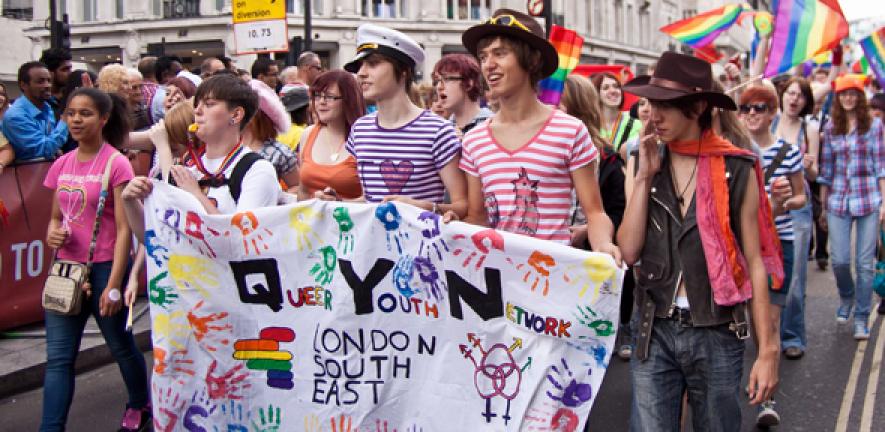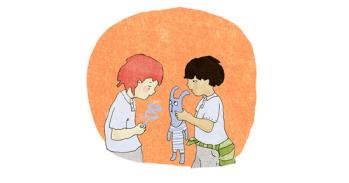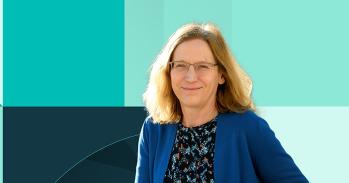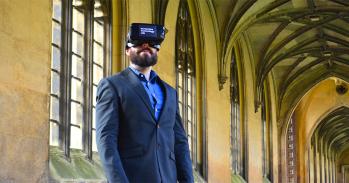
At the end of June, the charity Stonewall produced a report along with Cambridge’s Centre for Family Research into the experiences of lesbian, gay, bisexual and transgender pupils at our schools. On the eve of Pride London, Dr Nick Bampos, one of the University of Cambridge’s Equality and Diversity Champions looks at the findings.
At the end of June, the charity Stonewall produced a report along with Cambridge’s Centre for Family Research into the experiences of lesbian, gay, bisexual and transgender pupils at our schools. On the eve of Pride London, Dr Nick Bampos, one of the University of Cambridge’s Equality and Diversity Champions looks at the findings.
We – LGBT and straight alike – shouldn’t be too complacent. There is still a lot of work to be done
Nick Bampos
Tomorrow, tens of thousands of people will descend on London to celebrate Pride, the annual march through the streets of the city to celebrate lesbians, gays, people who are bisexual and transgender and those who belong to other sexual minorities – the LGBT+ community.
Where last year’s parade was swelled by people marching in solidarity with those tragically killed in the terrible shooting at Orlando earlier that month, this year’s may well be boosted by a positive celebration: fifty years since the decriminalisation of gay sex.
Anyone old enough to remember this point in history, or even the eighties, when the spectre of AIDS hung over the gay community and the Thatcher government introduced Section 28 to prohibit local authorities from "promoting" homosexuality, will realise how far we have come since then. In 2017 the rights of our LGBT friends in our community are protected in law, and same sex marriage is broadly accepted.
But while I don’t want to rain on everyone’s parade, we – LGBT and straight alike – shouldn’t be too complacent. There is still a lot of work to be done.
Last week, the charity Stonewall, which campaigns for equality for LGBT people in all walks of life, published a report looking at the experiences of LGBT pupils at our schools. The research behind this report was led by Dr Vasanti Jadva from Cambridge’s Centre for Family Research and was a follow up to its two previous studies, published in 2007 and 2012.
The findings of the study give us cautious optimism – but I want to stress that word, cautious. Compared to the previous studies, it found that pupils at our schools encounter less bullying based on their sexual or gender identity, are less likely to hear casual homophobic language such as “faggot” or “lezza” and are more likely to be taught about LGBT issues at school. But that does not mean that these problems have gone away. And for one group in particular – those pupils who define themselves as transgender – their experiences are far from positive.
More than 3,700 LGBT young people aged 11-19 across Britain took part in the study, completing an online questionnaire asking about their experiences at school, online and at home.
The top line finding of this important report is very positive: homophobic and biphobic bullying has fallen by a third over ten years. But this masks the fact that 45% of our pupils are still bullied because they are LGBT. And if you are trans, more likely than not you will have been bullied – 64% of trans pupils report being bullied. Even more horrifying, nearly one in ten trans pupils have been subjected to death threats at school.
Half of LGBT pupils frequently hear homophobic language at school. The phrase “that’s so gay” – used infamously by DJ Chris Moyles during his spell on Radio 1 – is still used very commonly, with 86% of pupils regularly hearing this or similar phrases at school.
What happens when teachers witness the bullying or hear such offensive language at school? Not enough, it seems. Fewer than a third of LGBT pupils say their teachers intervened when they were present during the bullying, and seven in ten say teachers only ‘sometimes’ or ‘never’ challenge homophobic, biphobic or transphobic language when they hear it.
There have been improvements, though: the number of schools that tell their pupils homophobic bullying is wrong is up from a shameful 25% when our researchers first did their study to 68% this time round. Faith schools are most likely to let their pupils down – just 57% tell their pupils that homophobic bullying is wrong, and only 29% tell them transphobic bullying is wrong.
Schools are more likely to teach their pupils about LGBT issues now, too. In 2007, 70% of pupils had never been taught about such matters, but this is down to 40% now. But again, if you’re trans, your experience is much worse – three in four LGBT pupils have never learnt about gender identity and what ‘trans’ means at schools (and in fact, this is a similar figure for bisexuality).
We know that positive role models can help pupils as they grow up, and it’s perhaps a reflection of the changing environment in which gays and lesbians can marry and are more visible that means that 27% of LGBT pupils known of an openly gay member of staff and 22% of an openly lesbian member of staff. But the stigma surrounding bisexuality and transgender is reflected in that only a tiny minority know staff in these groups (4% and 3% respectively).
So what does all this mean for a pupil’s development? We know that mental health issues among young people are becoming an increasing concern, and this is particularly reflected among LGBT pupils. An alarming 61% of LGBT pupils have deliberately harmed themselves, and more than one in five (22%) have attempted to take their own lives, a figure barely changed since 2012. This is just not acceptable.
Stonewall has rightly used the findings of the report to make a number of recommendations to improve the experiences of LGBT pupils across the country. Ruth Hunt, chief executive of Stonewall, described the report as “a wake-up call for schools, government and politicians on just how far we still have to go."
While some of the recommendations are aimed at ensuring that staff are empowered to offer appropriate support to their LGBT pupils, many are aimed at showing their pupils that it’s okay to be LGBT. If this report tells us one thing, it’s the importance of allowing people to celebrate who they are, no matter their sexuality or gender identity. It’s what we strive for at Cambridge, to be a university to which any student can aspire to come and not only engage in great scholarship, but to also be free, happy, and proud of their individuality and sexuality.
The Stonewall report encourages us to celebrate difference and make the diversity of LGBT people visible. This is what Pride is all about – and you can see the impact it can have by listening to those who have been fortunate enough to attend. Lauren, a 16 year old pupil in the East Midlands, who contributed to the study put it so clearly when saying that: “After I went to Pride, I felt much more confident and able to come out because of how well bisexuality was accepted there. Going to Pride helped me to gain confidence in myself and to come out.”
So go out there tomorrow, enjoy yourself. Be proud. And let our children and teenagers see that they, too, have so much to be proud about.
If you are an LGBT+ young person in or around looking for help and support, you can contact The Kite Trust, which offers free support for LGBT+ people under the age of 25.
The opinions expressed in this article are those of the individual author.

The text in this work is licensed under a Creative Commons Attribution 4.0 International License. For image use please see separate credits above.




